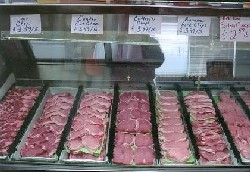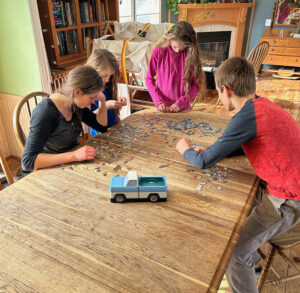Editor’s Note: Kevin Wright is a market gardener, and although this time of year is really busy for him, he made some time to get this article to Country Life. If you’d like start growing on a larger scale, and selling your own produce, he’s got some great tips and ideas. Â Â Â
I had just prepared the new bed. The earth below me was giving off that wonderful scent and I was so glad to be working it. The new bed was fifty feet in length and would be home to this year’s crop of potatoes. Three more beds need to be prepared for potatoes and  then I would be finished for the day.

My peas have been in for some time now and are growing beautifully. This year I did try something new. In my prepared row I tossed in the seeds without any spacing needs. The idea is to just let them grow and see where it takes me. Along with that, instead of setting up a traditional trellis system I have placed small fallen tree limbs in the ground within the rows. As the peas grow they will intermingle with the limbs and will be supported. I hope it works anyway!
My to-do list for this year’s market garden is lengthy. So many projects yet to go and so many new things to try. It seems that I can never be satisfied and must try out any idea that I think might work. Sure, I will never shy away from the tried and true ideas and that is why many of my attempted new ideas are tried in a small test area….just in case.
Weeks ago, I started several plants indoors, all growing strong now. Many of those are still a couple of weeks away from going in the ground. Started in seed trays, many have been transplanted into single pots. As the plants grow stronger, their root systems become more solid. I find that the best transplant pots are yogurt containers. Just put a few holes in the bottom for drainage, fill the appropriate soil, and you’re set.
Set Goals For Your Market Garden
Having a goal at the beginning of the season is of utmost importance for the market gardener. I consider myself a small-time market gardener. I think setting goals gets easier after you have done it for a few years as you come to a better understanding of what your general market location has to offer, and what you can expect from your plantings and harvests. With this in mind I still set high goals, but know that I may not reach them all. When the weather is your co-worker, sometimes you settle for good enough.

Let me explain how I establish my goals. In most markets today the tomato is king. It probably will always be king. I might set a goal of 500 pounds of tomatoes. With a best on-average yield of 100 lbs. per 100 row-feet of tomato plants (which is a perfect season) I’d better have at least 500 row-feet planted in tomatoes. That could mean as many as 250 plants.
I also need to estimate harvest poundage. I prefer to plant a indeterminate tomato. Inderterminates will keep growing as the season goes on. A determinate plant will produce all at once. It’s much easier to harvest and sell tomatoes that gradually ripen through the growing season than to sell 500 pounds of tomatoes that ripen all at once!
There are numerous web sites who post average yield charts and these are very important to the market gardener. Find what you are planting and see the average yield (almost all are based on 100 foot rows). Many of these sites will tell you as well about how many plants or seeds it will take for the 100 foot row. With this information seed ordering is a breeze! Start your seed indoors, and you’ll be ready to plant when the weather is right for individual crops.
Green beans are second on the list in my area. Everybody loves their green beans. But to stay ahead of the game you need to plant in succession. Even if you plant only one variety of bean, staggering the planting times will benefit you in the long run. I have seen countless times where many of the small markets have run out of green beans because everybody put them in at the same time and then they all ran out at the same time. Make several plantings a few weeks apart. This will always keep you in green beans throughout the season. Same is true if you do a lot of home canning. Spread your work out. No need to try and get all the beans canned at once. Work them throughout the summer.
Every season I have different ideas on how I will do my selling. Will I stick with the local markets, will I try to market my produce wholesale, will I make a stand as a freelancer? This year the answer is yes, I will try them all. In the next installment, I’ll explain how I do them.


































